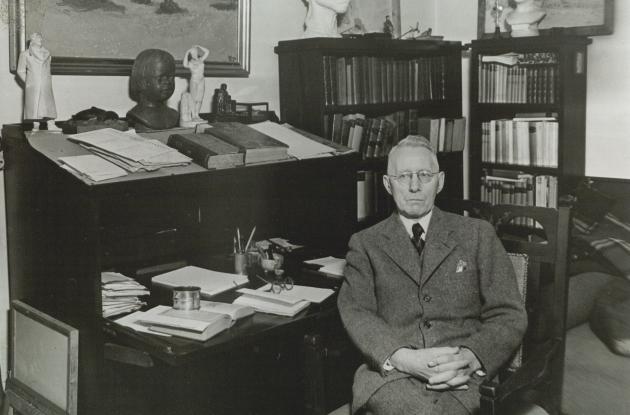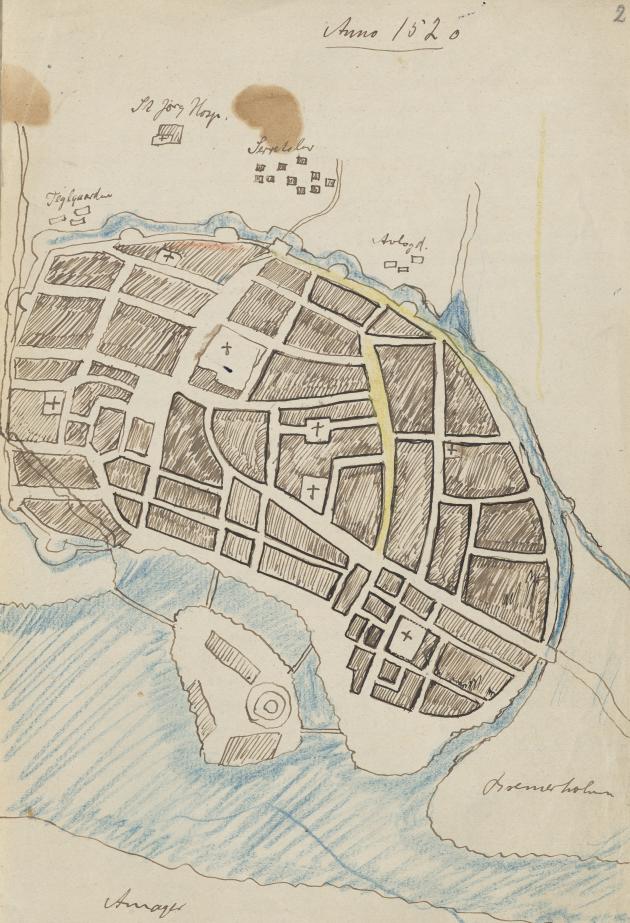Take a look over Johannes V. Jensen's shoulder
Not many of Johannes V. Jensen's manuscripts have survived, but the manuscript for his great novel The Fall of the King is in our collections and is the focal point for a completely new edition.

Photo: Københavns Foto-Service
Published 06 December 2023 | Revision 02 April 2025
Reading a manuscript for a novel is like getting a unique look over the author's shoulder. In the manuscript, you can follow the author's work process and the development of the story step by step before the final publication. But the Danish writer Johannes V. Jensen (1873-1950) did not want anyone to look over his shoulders, and therefore he burned many of his manuscripts and letters. A manuscript which (fortunately) did not turn to ashes is the manuscript for his great work The Fall of the King (1900-1901).
The manuscript's survival
That the manuscript for The Fall of the King has survived is more due to luck than to intelligence. The manuscript first appeared around the mid-1920s, when Frithiof Brandt (1892-1968) was visiting Jensen. Here Jensen found the manuscript, which had recently come into his hands again. Perhaps it had been at the parents' home in Farsø? In 1938, Jensen presented it as a gift to his close friend, art historian and cultural history writer Aage Marcus (1888-1985), who later donated it to Royal Danish Library. And here it has been stored ever since.
A new edition of the Fall of the King
The manuscript for The Fall of the King is the focal point for the new edition of the novel, which Jesper Gehlert Nielsen and Sven Hakon Rossel from the Danish Language and Literature Society are working on. In this edition, they put the manuscript side by side with the first edition of the novel, which gives the reader a completely new experience of the work.
It is not often that you publish a draft and a first edition together - but here it makes very good sense, because the reader can follow how he worked with the text and see how the whole story came to be. It contains some varying stories, which make it interesting to read compared to the first edition.

Photo: Johannes V. Jensen
An example of a change that Johannes V. Jensen made during the creation of the novel was the main character's name. In the script, his name was initially Jesper Petri, but the name was later changed to Mikkel Thøgersen; the name that also recurs in the first edition of the novel. You can also follow how Jensen himself became more aware of the historical facts, and see his drawing of Copenhagen anno 1520, as the city looked during the time of the novel. He had sketched the drawing from one of the sources he used for the description of Copenhagen at the time: Erich Pontoppidan's Originis Hafnienses or The Royal Residentz-Stad Kiöbenhavn from 1760.
Precisely the historical conditions are some of the things that can make The Fall of the King a confusing affair to read - unless you have the early 16th century Danish history fresh in your memory. Therefore, the new edition of the novel will contain historical explanations of, for instance, who King Christian II was and the historical events such as the Count's Feud (1534-1536) and the Stockholm Massacre (1529), which took place during the time period in which the action takes place.
"The Fall of the King is one of the titles that the reading world has long missed in a critical and annotated edition. Not only because many of the historical conditions call for an explanation, but in particular because it is a fantastic novel. The Fall of the King was named the novel of the century in Danish literature in 1999," says Jesper Gehlert Nielsen.
The project has been a long time in the making and will soon be ready for publication.
Read more about the project
Read more about the Danish Language and Literature Society's project here
View and read the manuscript
The Danish manuscript for The Fall of the King has been digitised and can be found in our digital collections. Click here to see and read Jensen's manuscript.